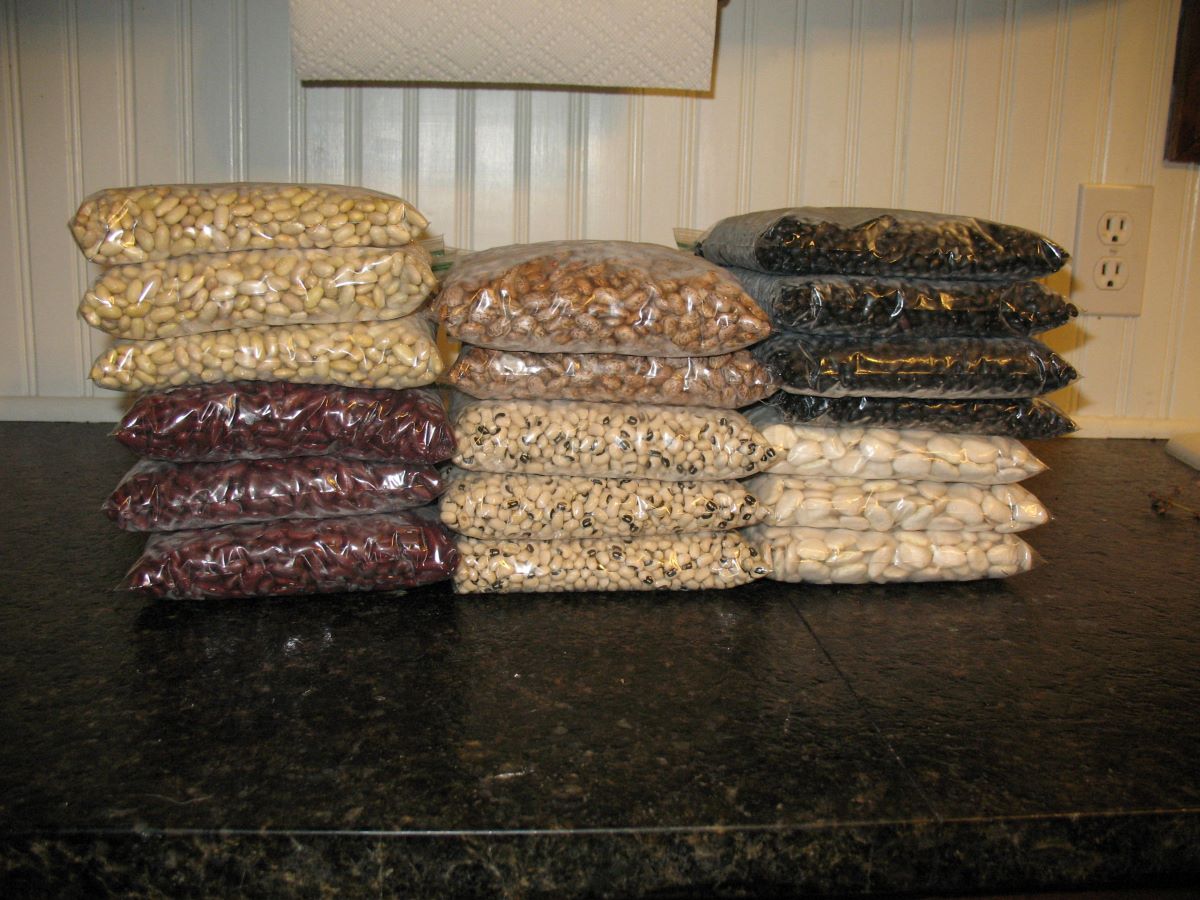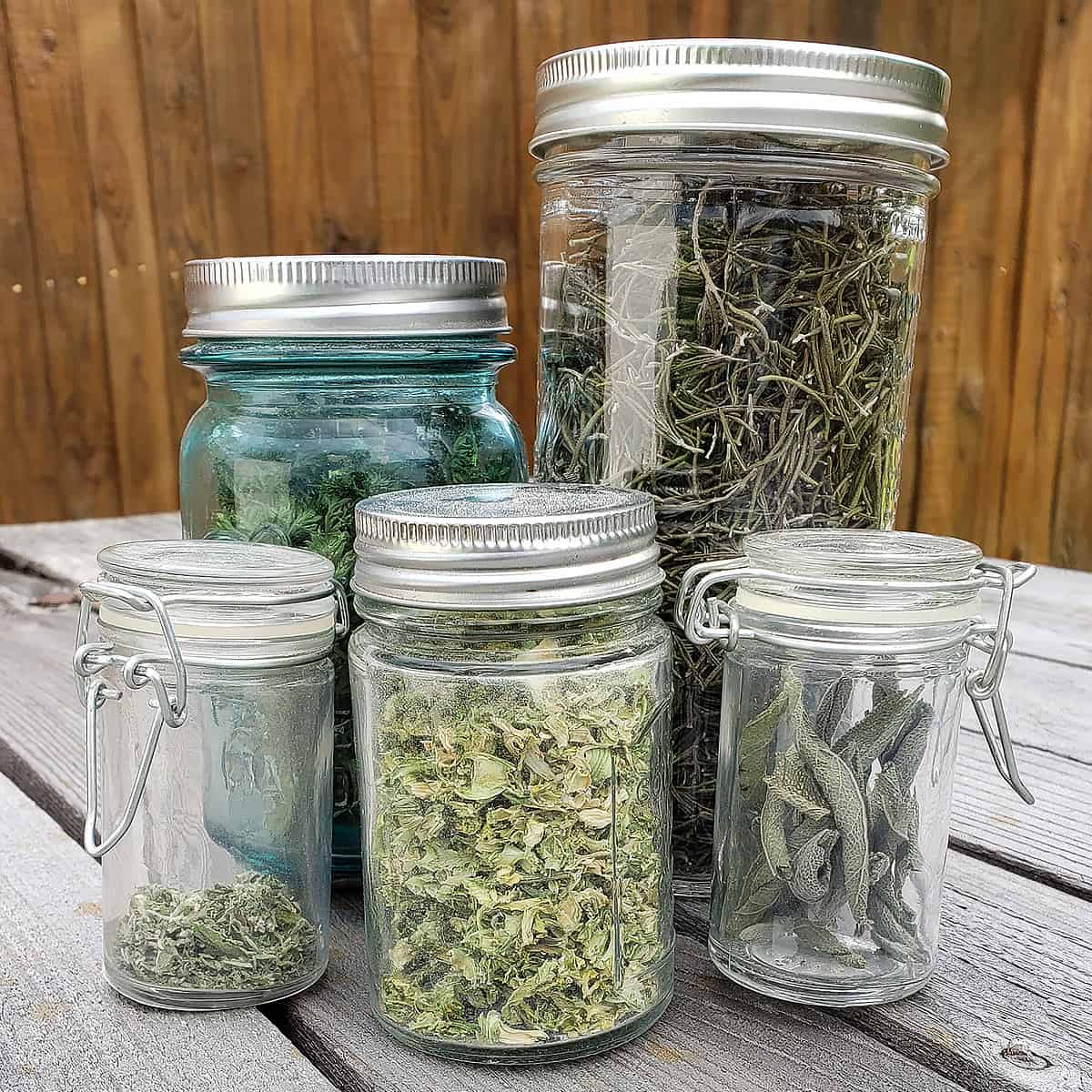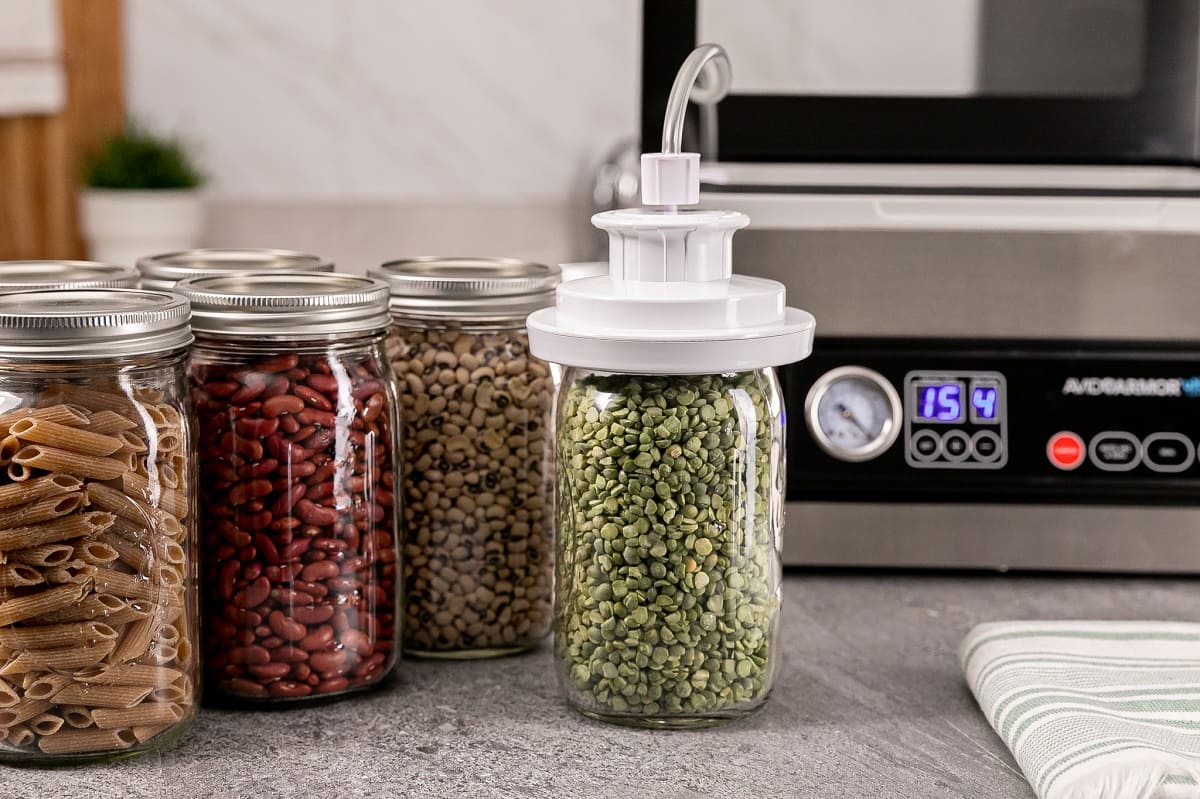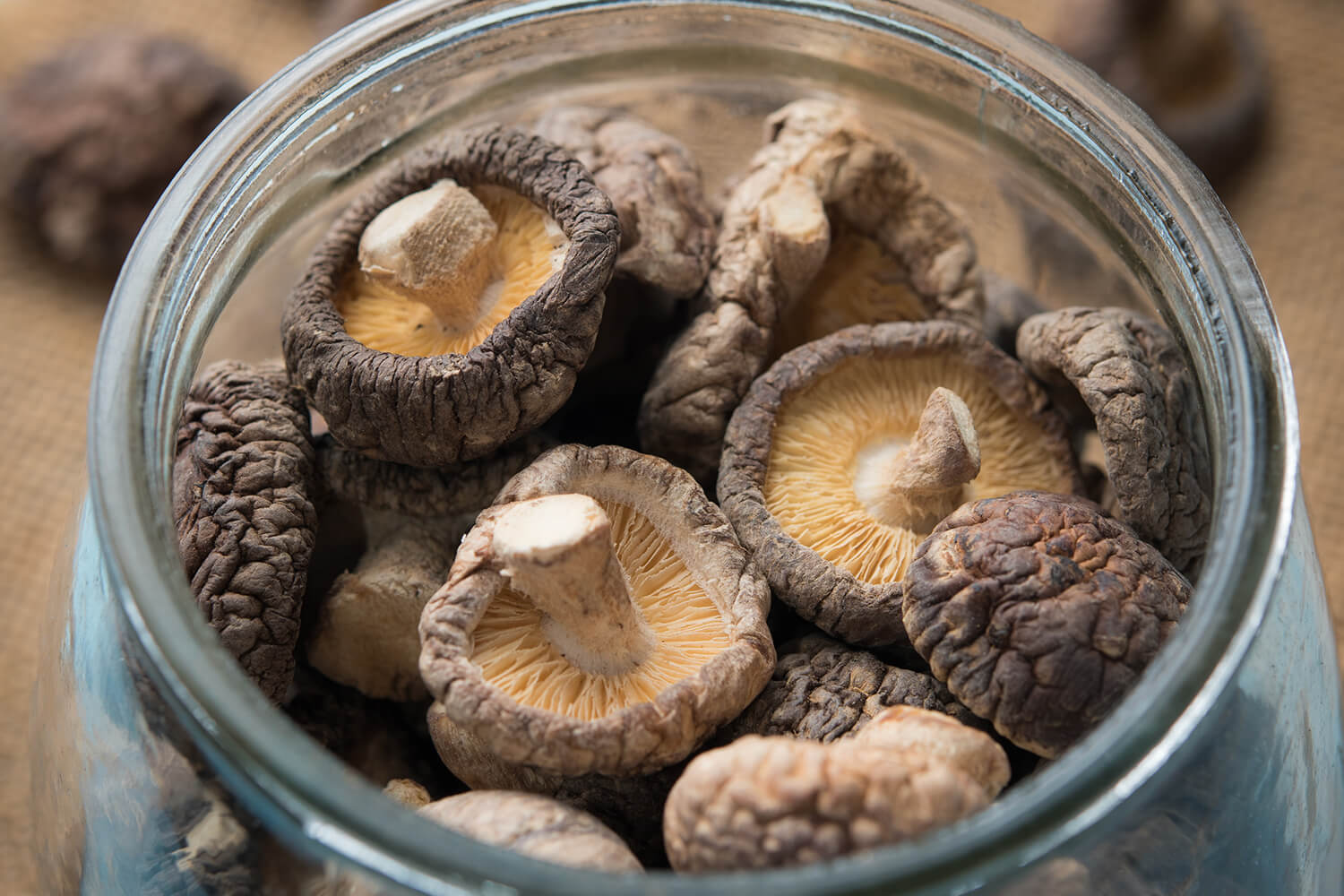

Articles
How To Store Dry Beans Long Term
Modified: February 29, 2024
Learn how to store dry beans long term with these helpful articles. Keep your beans fresh and ready to use for years to come.
(Many of the links in this article redirect to a specific reviewed product. Your purchase of these products through affiliate links helps to generate commission for Storables.com, at no extra cost. Learn more)
Introduction
When it comes to stocking your pantry for the long term, one item that should be at the top of your list is dry beans. These versatile legumes are not only nutritious and affordable, but they are also easy to store for extended periods. Whether you’re preparing for emergencies or simply looking to save money by buying in bulk, knowing how to properly store dry beans is essential.
Dry beans, such as kidney beans, black beans, pinto beans, and chickpeas, are a staple in many cuisines around the world. They are rich in protein, fiber, vitamins, and minerals, making them an excellent source of nutrition for vegetarian and vegan diets. In addition to their nutritional benefits, dry beans also have a long shelf life, especially when stored properly.
Storing dry beans long term offers several advantages. Firstly, it ensures that you have a readily available source of food in case of emergencies or natural disasters when access to fresh groceries may be limited. Secondly, it can save you money in the long run by allowing you to take advantage of bulk buying discounts or seasonal sales. Lastly, having a well-stocked pantry with dry beans gives you the flexibility to whip up delicious and nutritious meals at any time.
However, before you start storing dry beans, there are a few factors to consider. The storage environment, container choice, and preparation methods play a crucial role in preserving the quality and longevity of the beans. In this article, we will explore everything you need to know to store dry beans long term and make the most of this pantry staple.
Key Takeaways:
- Stocking your pantry with dry beans for long-term storage ensures a reliable, cost-effective, and versatile food source, offering nutritional benefits, emergency preparedness, and culinary flexibility.
- Properly preparing, storing, and utilizing dry beans maximizes their shelf life, flavor, and cooking potential, providing a sustainable and nutritious pantry staple for years to come.
Read more: How To Store Dried Beans And Rice Long Term
Why Store Dry Beans Long Term?
Storing dry beans long term offers numerous benefits that make it a worthwhile investment of your time and resources. Here are some compelling reasons why you should consider stocking up on dry beans for extended storage:
1. Long Shelf Life: Dry beans have an impressive shelf life, especially when compared to other perishable foods. When stored properly in a cool and dry environment, dry beans can last for several years. This makes them an ideal choice for long-term storage, ensuring you have a reliable food source whenever you need it.
2. Nutritional Value: Dry beans are packed with essential nutrients. They are an excellent source of protein, fiber, complex carbohydrates, vitamins, and minerals. By storing dry beans long term, you can maintain access to nutritious and wholesome food, even during challenging times when fresh produce may be scarce or unavailable.
3. Cost Savings: Buying dry beans in bulk often translates to significant cost savings. When you purchase larger quantities, you can take advantage of wholesale prices and discounts. By storing them long term, you can stock up during sales or when prices are low, saving money in the process. It’s a cost-effective strategy to build a well-stocked pantry without breaking the bank.
4. Emergency Preparedness: One of the main reasons to store dry beans long term is to be prepared for emergencies. Natural disasters, power outages, or unforeseen events can disrupt the food supply chain, leaving you without access to fresh groceries. Having a stockpile of dry beans ensures that you have a reliable source of sustenance during these challenging times.
5. Cooking Versatility: Dry beans are incredibly versatile in the kitchen. They can be used in a wide range of delicious recipes, from soups and stews to salads and spreads. By storing dry beans long term, you’ll always have this versatile ingredient on hand, allowing you to create satisfying meals with minimal effort.
Considering these compelling reasons, it’s evident that storing dry beans long term is a wise and practical choice. Not only do you ensure a constant supply of nutritious food, but you also save money, have peace of mind during emergencies, and enjoy culinary flexibility. Now, let’s explore the factors you should consider before storing dry beans.
Factors to Consider Before Storing Dry Beans
Before you start storing dry beans for the long term, there are a few important factors to consider. These factors will ensure that the beans remain in optimal condition and retain their quality throughout the storage period. Let’s take a closer look at what you need to keep in mind:
1. Quality of Beans: It’s essential to start with high-quality beans for long-term storage. Choose beans that are free from any signs of spoilage, such as mold, insect damage, or shriveled appearance. Investing in fresh and high-quality beans at the beginning will ensure better longevity and taste.
2. Moisture Content: Moisture is the enemy when it comes to storing dry beans. Excessive moisture can lead to mold growth and spoilage. Before storing the beans, make sure they are completely dry. Allow them to air-dry for a few days or use a dehydrator to remove any remaining moisture.
3. Cleaning the Beans: It’s crucial to thoroughly clean the beans before storage. Remove any debris, stones, or foreign particles by washing them under running water. This will ensure that the beans remain free from contaminants during the storage period.
4. Pest Control: Dry beans are susceptible to insect infestations, which can compromise their quality. To prevent pests, consider freezing the beans for a few days before storage to kill any potential insect eggs. You can also use food-grade diatomaceous earth or oxygen absorbers to deter pests.
5. Storage Conditions: Proper storage conditions are vital for preserving the quality and longevity of dry beans. The ideal environment for storing dry beans is cool, dark, and dry. Aim for a temperature below 70°F (21°C) and a humidity level below 60%. Avoid exposure to direct sunlight or extreme temperature fluctuations.
6. Container Selection: Choosing the right container is crucial for long-term storage. Opt for food-grade containers that are airtight and moisture-proof. Avoid using containers made of materials that can interact with the beans, such as plastic that may release harmful chemicals. Glass jars or food-grade plastic containers with tight-fitting lids are excellent choices.
7. Proper Labeling and Rotation: To maintain a well-organized pantry and ensure freshness, label your containers with the date of storage. Additionally, practice a first-in, first-out rotation system. Use the oldest beans first, ensuring that you’re constantly cycling through your stored supply.
By considering these factors before storing dry beans, you’ll set yourself up for success. Taking the time to prepare the beans properly and create the optimal storage conditions will ensure that your supply remains in excellent condition and provides you with nourishing meals for years to come.
Choosing the Right Container for Long-Term Storage
When it comes to storing dry beans for the long term, choosing the right container is crucial. The container you select will play a significant role in preserving the quality, flavor, and nutritional value of the beans. Here are some factors to consider when choosing a container for long-term storage:
Airtight and Moisture-Proof: The container should be airtight and moisture-proof to prevent air, moisture, and pests from reaching the beans. This will help maintain their freshness and prevent spoilage. Look for containers with tight-fitting lids or seals to ensure a proper seal.
Food-Grade Material: Opt for containers made of food-grade materials that are safe for storing food. Glass jars, metal cans, or food-grade plastic containers are commonly used for dry bean storage. Avoid containers made of materials that can interact with the beans or leach harmful chemicals, such as certain types of plastics.
Opaque and Light-Blocking: Choose containers that are opaque or made of dark-colored materials to block out light. Exposure to light can cause beans to lose their color, flavor, and nutrients over time. It’s best to store dry beans in a dark environment to maintain their quality.
Size and Shape: Consider the size and shape of the container based on your storage needs. Smaller containers are easier to handle and rotate, especially if you frequently use the beans. However, if you’re storing a large quantity of beans, larger containers might be more practical. Stackable containers can help save space in your pantry.
Durable and Long-Lasting: Look for containers that are durable and can withstand long-term storage. They should be able to withstand temperature fluctuations and resist cracking or breaking. Investing in high-quality containers will ensure that they last for years, providing reliable storage for your beans.
Clear Labeling: Properly labeling your containers is essential for easy identification and organization. Label each container with the type of bean, date of storage, and any other relevant information. This will help you keep track of your stock and practice proper rotation to ensure freshness.
Consider Multiple Containers: Depending on the quantity of beans you plan to store, it may be wise to divide them into multiple containers. This can provide added protection and convenience. If one container is compromised, you won’t risk losing your entire supply.
By carefully choosing the right container for long-term storage, you can ensure that your dry beans remain fresh, flavorful, and nutrient-rich for an extended period. Airtight, food-grade containers that block out light and moisture will be your best choice to preserve the quality of your beans. In the next section, we’ll explore how to properly prepare dry beans for storage.
Preparing Dry Beans for Storage
Before storing dry beans for the long term, proper preparation is necessary to ensure their longevity and quality. Taking a few extra steps will help preserve the beans and protect them from potential spoilage. Here are some essential guidelines for preparing dry beans for storage:
1. Sorting and Cleaning: Start by sorting through the dry beans to remove any damaged or discolored beans, as well as any foreign objects. Once sorted, rinse the beans under cold water to remove any dirt or debris. This step is crucial to ensure that only clean beans are stored.
2. Soaking: Soaking dry beans prior to storage can help reduce cooking time and improve their texture once cooked. There are two common methods for soaking: the overnight soak and the quick soak. For the overnight soak, cover the beans with water and let them soak overnight. For the quick soak, boil the beans in water for a few minutes, then remove from heat and let them soak for an hour. Rinse the beans after soaking.
3. Drying: After soaking, it’s important to dry the beans thoroughly before storing them. Spread the beans out on a clean towel or baking sheet and allow them to air-dry completely. Make sure there is no moisture remaining on the beans, as this can lead to mold growth during storage.
4. Packaging: Once the beans are dry, transfer them to your chosen airtight containers for long-term storage. Be sure to label each container with the type of beans and the date of storage. This will help you keep track of their freshness and ensure proper rotation.
5. Freezing (Optional): If you want to take extra precautions to protect against potential pest infestations, you can freeze the beans for a few days before placing them in long-term storage. Freezing will kill any potential insect eggs or larvae that may be present.
6. Oxygen Absorbers (Optional): To further extend the shelf life of the beans and prevent the growth of mold or pests, you can add oxygen absorbers to each container. These packets contain iron powder that absorbs oxygen, creating an oxygen-free environment.
7. Store in a Cool, Dark, and Dry Place: Finally, store your containers of dry beans in a cool, dark, and dry location, such as a pantry or cellar. Avoid areas that are prone to temperature fluctuations or exposure to sunlight. Remember to keep the storage area well-ventilated to prevent the buildup of moisture.
By following these steps to prepare dry beans for storage, you can maximize their shelf life and maintain their quality. Properly sorted, cleaned, soaked, dried, and packaged beans will be well-protected and ready to be used whenever you need them. In the next section, we will explore different methods for storing dry beans long term.
Store dry beans long term in a cool, dark, and dry place, such as a pantry or cellar. Keep them in airtight containers to prevent moisture and pests. Rotate stock to ensure freshness.
Read more: How To Store Beans Long Term
Methods for Storing Dry Beans Long Term
Storing dry beans long term requires proper methods to ensure their freshness, flavor, and nutritional value remain intact. Here are a few effective methods for storing dry beans for an extended period:
1. Airtight Containers: One of the most common methods is storing dry beans in airtight containers. Transfer the dried and prepared beans to food-grade containers with tight-fitting lids. Ensure that the containers are completely airtight to prevent air and moisture from entering. This method helps protect the beans from spoilage and keeps them fresh for an extended period.
2. Mylar Bags: Using Mylar bags is another excellent option for long-term storage of dry beans. Mylar bags are made of a durable and moisture-resistant material that provides an extra layer of protection against air, light, and pests. Place the prepared beans in the Mylar bags, remove as much air as possible, and seal them using a heat sealer. Stored properly, beans in Mylar bags can last for several years.
3. Mason Jars: Mason jars are a classic choice for storing dry beans long term. Choose jars with airtight lids and pack the prepared beans tightly into the jars, leaving about an inch of headspace. Ensure the beans are completely dry before sealing the jars. Store the jars in a cool, dark place away from direct sunlight. Mason jars add a rustic touch to your pantry and make it easy to see the contents at a glance.
4. Vacuum Sealing: Vacuum sealing is a popular method for long-term preservation of dry beans. Use a vacuum sealer to remove the air from the packaging and create a tight seal. This helps to prevent oxygen and moisture from reaching the beans, extending their shelf life. Vacuum-sealed bags are also space-efficient and can be easily stored in bins or containers.
5. Freezing: Freezing is an option if you want to store dry beans for an even longer period. However, it’s important to note that freezing may affect the texture of the beans. Before freezing, ensure the beans are completely dry and store them in airtight freezer-safe containers or freezer bags. Label the containers with the type of beans and the date of freezing. When ready to use, thaw the beans before cooking.
6. Grain Silos or Food-Grade Buckets: For larger quantities of dry beans, consider using grain silos or food-grade buckets with airtight lids. These containers are designed to store bulk grains and are suitable for long-term storage of dry beans. Before using them, ensure they are clean and free from any lingering odors that could affect the beans.
Regardless of the method you choose, it’s crucial to store the beans in a cool, dark, and dry place. Avoid exposing them to sunlight or extreme temperature fluctuations, as this can accelerate spoilage. Regularly inspect and rotate your stock to ensure freshness and maintain a well-stocked pantry.
By employing these methods for storing dry beans long term, you can enjoy the convenience and nutritional benefits of this pantry staple for a considerable period. In the next section, we will discuss how to monitor and maintain the storage environment to preserve the quality of your stored dry beans.
Monitoring and Maintaining the Storage Environment
Once you have stored your dry beans using the appropriate methods, it is essential to monitor and maintain the storage environment to ensure the beans remain in optimal condition. Here are some key factors to consider when monitoring and maintaining the storage environment:
Temperature: Dry beans should be stored in a cool environment with a temperature below 70°F (21°C). Exposure to high temperatures can cause the beans to spoil and lose their quality. Avoid storing them near heat sources such as stoves, ovens, or direct sunlight. Fluctuations in temperature can also accelerate spoilage, so aim for a consistent and cool storage area.
Humidity: Keeping the storage environment dry is crucial for preventing moisture buildup and the growth of mold or bacteria. Ideally, the humidity level should be below 60%. High humidity can lead to clumping, molding, or sprouting of the beans. Use a dehumidifier or moisture absorber in the storage area if needed, especially in humid climates.
Ventilation: Proper airflow is important in maintaining the quality of stored dry beans. Ensure that the storage area is well-ventilated to prevent the buildup of stagnant air. Good ventilation helps reduce the risk of moisture accumulation and maintains a fresh storage environment. Avoid tightly packing containers, as this can restrict airflow.
Light: Exposure to light can cause dry beans to lose their color, flavor, and nutritional value over time. Store the beans in a dark area or use opaque containers that block out light. If your storage area has windows, cover them with curtains or blinds to prevent sunlight from reaching the beans. This will help preserve their quality and prolong their shelf life.
Regular Inspections: Regularly inspect your stored dry beans for any signs of spoilage, such as mold, insects, or off odors. Check the containers for any damage or signs of leaks. If you notice any issues, remove the affected beans immediately to prevent contamination of the rest of your stock. This will ensure that you are consuming safe and high-quality beans.
Rotation: Practicing proper rotation is crucial for maintaining freshness. Use the oldest beans first before moving on to the newer ones. Label your containers with the date of storage and use a first-in, first-out approach. By regularly using and replenishing your stock, you can ensure that the beans remain in optimal condition and avoid wastage.
Monitoring Tools: Consider using monitoring tools such as temperature and humidity gauges in your storage area. These tools can provide accurate readings and help you maintain an ideal storage environment for your dry beans. Monitor the readings regularly and make adjustments as needed to ensure the conditions are optimal.
By monitoring and maintaining the storage environment, you can prolong the shelf life of your stored dry beans and ensure their quality over time. By keeping an eye on temperature, humidity, ventilation, light exposure, and practicing proper rotation, you can enjoy fresh and flavorful beans whenever you need them.
Next, let’s explore some useful tips for using the stored dry beans in your everyday cooking.
Tips for Using Stored Dry Beans
Having a well-stocked pantry of stored dry beans provides you with a versatile ingredient that can be used in a variety of dishes. Here are some helpful tips for using your stored dry beans:
1. Rehydration: Before using your stored dry beans, it’s necessary to rehydrate them. Soaking the beans overnight or using the quick soak method can help soften them and reduce cooking time. Follow the recommended soaking guidelines for the specific variety of beans you are using.
2. Cooking Methods: There are several cooking methods you can employ to prepare your stored dry beans. These include stovetop simmering, pressure cooking, slow cooking, and using a multicooker or instant pot. Experiment with different cooking methods to find the one that yields the desired texture and flavor for your dishes.
3. Flavoring: While dry beans have a natural earthy flavor, you can enhance their taste by adding various seasonings and aromatics. Common flavorings include onions, garlic, herbs like bay leaves or thyme, spices, and vegetable or chicken broth. Don’t be afraid to get creative and personalize the flavors to suit your preferences.
4. Bean-to-Water Ratio: To achieve the desired texture when cooking your stored dry beans, it’s crucial to follow the recommended bean-to-water ratio. Different beans have different ratios, so refer to cooking guidelines or recipes for the specific variety you are using. Adjust the ratio based on your preferred consistency—firmer or creamier.
5. Pre-Soaking Liquid: When rehydrating dry beans, it’s recommended to discard the pre-soaking liquid and use fresh water for cooking. This helps eliminate any anti-nutrients present in the soaking liquid and reduces the likelihood of digestive discomfort. Fresh water ensures a clean and flavorful result.
6. Freezing Cooked Beans: If you have extra cooked beans, freezing them in portion sizes can be a convenient option. Spread the cooked beans on a baking sheet and freeze them individually before transferring to freezer bags or containers. This allows you to take out only the amount needed for a particular recipe without defrosting the entire batch.
7. Bean-Based Recipes: Explore a variety of bean-based recipes to diversify your meals. Dry beans can be used in soups, stews, chili, salads, dips, bean burgers, casseroles, and more. They can even be mashed and seasoned as a substitute for meat in vegetarian or vegan dishes. Get creative and experiment with different cuisines and flavors.
8. Canned Bean Substitutes: In recipes that call for canned beans, you can substitute your stored dry beans by adjusting the cooking time. Simply cook your dry beans until they reach the desired tenderness or until they are equivalent to the canned beans required. This allows you to use your stored beans in a wider range of recipes.
9. Bean Flour: Instead of cooking the beans whole, you can also grind them into flour. This bean flour can be used as a gluten-free alternative in baking recipes or as a thickening agent in sauces and stews.
10. Don’t Overlook Bean Broth: The liquid left after cooking beans, known as bean broth or bean cooking water, is not to be discarded. It can be a flavorful addition to soups, sauces, or used as a base for cooking grains like rice or quinoa. It contains nutrients released during cooking and offers a savory depth of flavor.
By following these tips, you can make the most of your stored dry beans and incorporate them into an array of delicious and nutritious meals. Get creative in the kitchen and enjoy the versatility that dry beans have to offer.
Now, let’s wrap up our discussion on storing dry beans long term.
Conclusion
Storing dry beans long term is not only a practical approach to emergency preparedness but also a cost-effective way to stock your pantry with a versatile and nutritious ingredient. By following the proper methods for storage and taking necessary precautions, you can ensure that your dry beans stay fresh, flavorful, and ready to use for years to come.
We explored the factors to consider before storing dry beans, such as ensuring the quality of the beans, moisture content, cleaning, pest control, and selecting the right container. Preparing the beans involves sorting, cleaning, soaking, and drying them thoroughly before packaging them into airtight containers or using alternative methods such as Mylar bags or vacuum sealing.
The storage environment is crucial in maintaining the quality of the beans. Monitoring and maintaining factors such as temperature, humidity, ventilation, light exposure, regular inspections, and proper rotation are vital to ensure that the beans remain in optimal condition.
When it comes to utilizing stored dry beans, rehydrating them through soaking and employing different cooking methods opens up a world of culinary possibilities. Experimenting with flavors, bean-to-water ratios, freezing cooked beans for convenience, and incorporating dry beans into a variety of recipes can spice up your meals and provide you with wholesome nutrition.
In conclusion, storing dry beans long term offers numerous benefits, including long shelf life, cost savings, emergency preparedness, and cooking versatility. By understanding the factors involved in proper storage, preparing the beans adequately, and monitoring the storage environment, you can maximize the longevity of your dry beans and enjoy their benefits for years to come.
So, start building your stock of dry beans today, and be ready to savor the nutritional benefits and culinary delights they bring to your kitchen, even in the face of unexpected events.
Frequently Asked Questions about How To Store Dry Beans Long Term
Was this page helpful?
At Storables.com, we guarantee accurate and reliable information. Our content, validated by Expert Board Contributors, is crafted following stringent Editorial Policies. We're committed to providing you with well-researched, expert-backed insights for all your informational needs.















0 thoughts on “How To Store Dry Beans Long Term”